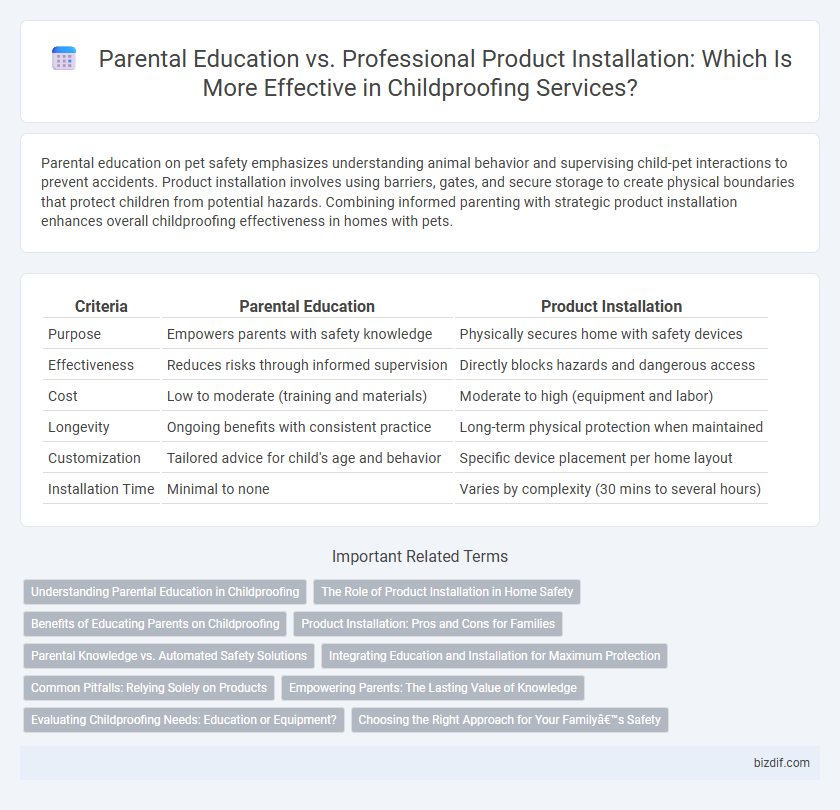Parental education on pet safety emphasizes understanding animal behavior and supervising child-pet interactions to prevent accidents. Product installation involves using barriers, gates, and secure storage to create physical boundaries that protect children from potential hazards. Combining informed parenting with strategic product installation enhances overall childproofing effectiveness in homes with pets.
Table of Comparison
| Criteria | Parental Education | Product Installation |
|---|---|---|
| Purpose | Empowers parents with safety knowledge | Physically secures home with safety devices |
| Effectiveness | Reduces risks through informed supervision | Directly blocks hazards and dangerous access |
| Cost | Low to moderate (training and materials) | Moderate to high (equipment and labor) |
| Longevity | Ongoing benefits with consistent practice | Long-term physical protection when maintained |
| Customization | Tailored advice for child's age and behavior | Specific device placement per home layout |
| Installation Time | Minimal to none | Varies by complexity (30 mins to several hours) |
Understanding Parental Education in Childproofing
Parental education in childproofing equips caregivers with essential knowledge about potential household hazards and safe practices to prevent accidents. This proactive approach emphasizes behavior modification and awareness, enabling parents to identify risks beyond the capabilities of physical product installations. Understanding and applying safety guidelines empowers families to create a safer environment adaptable to changing developmental stages of the child.
The Role of Product Installation in Home Safety
Product installation plays a critical role in enhancing home safety by securing potentially hazardous areas and items, such as cabinets, outlets, and stair gates. Properly installed safety products reduce risks of accidents and injuries among children by creating effective physical barriers. This hands-on approach complements parental education by providing tangible protection within the home environment.
Benefits of Educating Parents on Childproofing
Educating parents on childproofing empowers them to identify potential hazards and implement customized safety measures tailored to their home environment. This proactive approach fosters long-term awareness and confidence, reducing reliance on temporary fixes. Parental education enhances vigilance and ensures continuous adaptation to a growing child's developmental stages, leading to sustained accident prevention.
Product Installation: Pros and Cons for Families
Product installation in childproofing offers immediate safety enhancements by securing hazardous areas and reducing accident risks within the home. Professional installation ensures proper fitting and compliance with safety standards, minimizing potential failure compared to DIY methods. However, costs can be higher and some products may limit furniture placement or space usability, requiring families to balance safety benefits with home functionality.
Parental Knowledge vs. Automated Safety Solutions
Parental knowledge enhances child safety by empowering caregivers to recognize and mitigate potential hazards through informed supervision and behavior modification. Automated safety solutions, such as smart locks and sensor alarms, provide consistent protection by physically restricting access to dangerous areas and alerting parents to risks without relying solely on vigilance. Integrating both parental education and automated installations creates a comprehensive childproofing strategy that reduces accidents and supports proactive prevention.
Integrating Education and Installation for Maximum Protection
Integrating parental education with childproofing product installation significantly enhances home safety by empowering caregivers with knowledge and practical tools. Trained professionals provide tailored guidance on hazard identification while installing safety devices such as cabinet locks, outlet covers, and stair gates to create a comprehensive protection system. This combined approach reduces injury risks and promotes proactive safety habits in the family environment.
Common Pitfalls: Relying Solely on Products
Relying solely on childproofing products often leads to a false sense of security, neglecting essential parental education on hazard awareness and supervision techniques. Many parents overlook the importance of understanding proper product usage, resulting in ineffective protection and potential safety gaps. Combining product installation with comprehensive parental education ensures a safer environment by addressing both physical barriers and informed vigilance.
Empowering Parents: The Lasting Value of Knowledge
Parental education in childproofing empowers caregivers with critical knowledge, enabling them to identify potential hazards and make informed safety decisions tailored to their unique home environment. Unlike product installation alone, which provides immediate but limited protection, education fosters lasting confidence and proactive risk management. This holistic approach reduces dependency on external solutions and cultivates a safer, more responsive household dynamic.
Evaluating Childproofing Needs: Education or Equipment?
Evaluating childproofing needs requires balancing parental education with professional product installation to ensure comprehensive safety. Parental education empowers caregivers with knowledge of potential hazards and preventive strategies, while product installation provides tangible barriers like safety gates, cabinet locks, and outlet covers. Combining informed parenting with properly installed safety equipment maximizes protection and reduces injury risks in the home environment.
Choosing the Right Approach for Your Family’s Safety
Parental education empowers caregivers with essential safety knowledge and strategies to prevent accidents, fostering long-term vigilance within the home environment. Product installation offers immediate, tangible barriers such as safety gates, outlet covers, and cabinet locks that reduce risk by physically limiting access to hazards. Selecting the right approach depends on your family's lifestyle, children's developmental stages, and willingness to maintain preventive measures, ensuring a customized balance between awareness and protection.
Parental Education vs Product Installation Infographic

 bizdif.com
bizdif.com